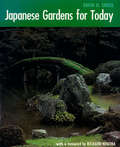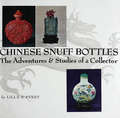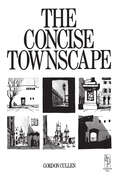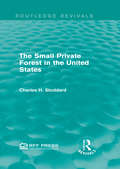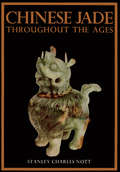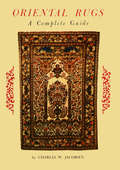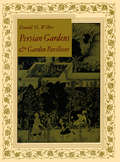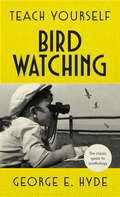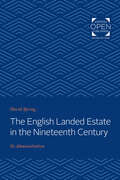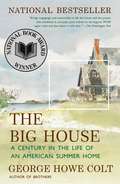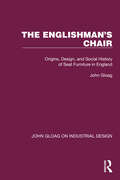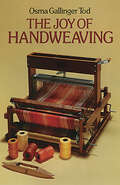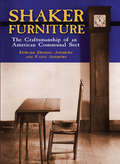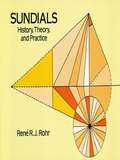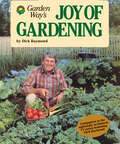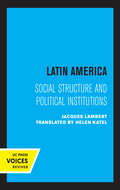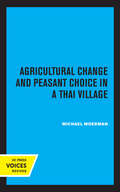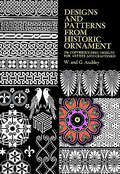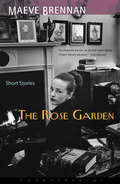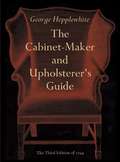- Table View
- List View
Japanese Gardens for Today
by David EngelWith extensive photographs and diagrams, this book explains the philosophy and practice of Japanese gardening.<P><P>An important classic of gardening instruction, Japanese Gardens for Today is a practical down-to-earth explanation of the basic rules of Japanese garden design and care. It is sure to prove of great value to both the professional landscape architect and to the green-thumbed home owner, whether he is designing an entirely new garden or only seeking an illusion of spaciousness and rightness in a tiny courtyard or corner.Photographs of historic Japanese gardens and the private, modern gardens of Japanese homes are given alongside useful rule-of-thumb practices and techniques. The books wealth of drawings are fully integrated with clear, succinct text to present the first full and practical treatment of the subject ever published in English.
Chinese Snuff Bottles
by Lilla S. PerryThis title was originally published in print form by Tuttle Publishing in 1960This book is not only an invaluable document for all interested in the history of Chinese art, but also a lucid and fascinating guidebook for the collector or would be collector, both of snuff bottles and other products of Chinese craftsmanship.
Concise Townscape
by Gordon CullenThis book pioneered the concept of townscape. 'Townscape' is the art of giving visual coherence and organization to the jumble of buildings, streets and space that make up the urban environment. It has been a major influence on architects, planners and others concerned with what cities should look like.
The Small Private Forest in the United States (Routledge Revivals)
by Charles H. StoddardThroughout the past few decades, the standard answer to the problem of low productivity in small private forests has been education. It has been assumed that the chief obstacle to "good" forestry has been lack of knowledge. But the stubborn persistence of the problem raises some doubts as to the efficacy of the remedy. In this book, first published in 1961, the author takes a sharper look at this problem. He tries to find out what has worked reasonably well, and what has not, and makes some suggestions as to what seems to offer the best prospects for the future. The Small Private Forest in the United States will be of interest to students of environmental studies, as well as to private landowners.
Chinese Jade Throughout the Ages
by Stanley Charles NottFirst published in 1936 and since then a collector's item of increasing rarity, Chinese Jade Throughout the Ages comprises a review of the characteristics, decorations, folklore, and symbolism of this esteemed mineral that has always held a proud place among gems of the world. The book presents a full descriptive account of the significance and meaning of the carvings produced in this prize stone by Chinese craftsmen from the earliest times, through the Chou and succeeding dynasties, down to the twentieth century.
Oriental Rugs a Complete Guide
by Charles W. JacobsenThis authoritative reference contains a vast amount of information about Oriental rugs.<P><P>Oriental Rugs: A Complete Guide is the first large volume on the subject to be printed in the past forty-five years is meant for the individual who is interested in purchasing his first Oriental Rug, as well as the collector, museum, and rug importer.The volume is divided into three main parts. Part I, entitled "General Discussion devotes one chapter to each of the large rug weaving countries and includes helpful hints as to what the rug buyer should look for in an particular rug.Part II, "Description of Types," is an alphabetical list of all the names that have been used to identify rugs in the past, as well as the names that are being used at present. Each entry is followed by a full discussion and description of the rug.Part III, "Plates," contains 194 pictures of different types of rugs, complete with descriptive captions for each. Thirty-nine of the plates are in full color. All of the plates are large, allowing the reader to see the design, and in some cases, the colors used in the particular rug.
Persian Gardens & Garden Pavilions
by Donald N. WilberThis Persian gardening book showcases classic gardens and pavilions and presents gardening advice for the aspiring amateur landscaper looking to add an Eastern flair to his or her yard.The garden has always had a special meaning for Persian (Iran). <P><P>The Persian garden, with its flowing pools, fountains, waterways, rows of tall trees, rich arrays of fruit trees and flowers, and cool pavilions, has represented an image of paradise.Persian Gardens & Garden Pavilions is both a comprehensive survey and an appreciation of this Persian tradition of gardens and garden pavilions. The text traces the historical development of Persian gardens, describes their basic features, presents existing examples, and discusses the literature and tradition behind them. The 119 illustrations include detailed plans and photographs of surviving gardens and their pavilions made on the spot, as well as a comprehensive collection of paintings, lithographs, and drawings of the nineteenth century executed both by Persian artists and by European travelers and emissaries of the period.The author points out, the gardeners who read this book should come across many details and ideas that can be incorporated into their own kinds of gardens.
Teach Yourself Bird Watching: The classic guide to ornithology (Teach Yourself)
by George E. HydeWith a few sorry exceptions, it's heartening to think that the gardener or bird-spotter of the 1950s or 60s would immediately recognise most of the songs that sing out over English gardens today. For the amateur ornithologist of the twenty first century, Teach Yourself Bird Watching will be as much of a delight now as it ever was - a beautifully written, precise guide to identifying, protecting and encouraging birdlife in your garden and beyond.Since 1938, millions of people have learned to do the things they love with Teach Yourself. Welcome to the how-to guides that changed the modern world.
Teach Yourself Bird Watching: The classic guide to ornithology
by GE HydeWith a few sorry exceptions, it's heartening to think that the gardener or bird-spotter of the 1950s or 60s would immediately recognise most of the songs that sing out over English gardens today. For the amateur ornithologist of the twenty first century, Teach Yourself Bird Watching will be as much of a delight now as it ever was - a beautifully written, precise guide to identifying, protecting and encouraging birdlife in your garden and beyond.Since 1938, millions of people have learned to do the things they love with Teach Yourself. Welcome to the how-to guides that changed the modern world.
The English Landed Estate in the Nineteeth Century: Its Administration
by David SpringOriginally published in 1963. The English Landed Estate in the Nineteeth Century: Its Administration deals principally with the administration of large landed estates during the years from 1830 to 1870. The book also throws new light on the work of the Inclosure Commissioners, who, as a department of the central government, supervised agricultural improvements made by landowners who borrowed from the government and from land companies. Author David Spring argues that the British government intervened in agriculture much more than is commonly thought. In describing the hierarchy of estate management, Spring relies, wherever possible, on hitherto unused family papers and estate documents. Especially important is his material on the Dukes of Bedford and on the domestic economy and financial position of the Russell Family. The chapter titled "The Landowner," based on the seventh Duke of Bedford's correspondence with his agent, is a case study of a single estate and provides insight into the workings of a great landowner's mind. The remaining chapters, dealing with lawyers, land agents, and the Inclosure Commissioners, include other individual portraits. Among these are Christopher Haedy, the Duke of Bedford's chief agent; James Loch, king of estate agents in nineteenth-century England; Henry Morton, the Earl of Durham's land agent; and William Blamire and James Caird, two of the Inclosure Commissioners.
Narcotics: Nature's Dangerous Gifts
by Norman TaylorInformation on marijuana, opium, morphine, heroin, coca, cocaine, alcohol, tobacco, ololiuqui, peyotl (mescaline), pituri, fly agaric, caapi, kava, betel, coffee, chocolate and tea.
The Big House: A Century in the Life of an American Summer Home
by George Howe ColtIn this intimate and poignant history of a sprawling century-old summer house on Cape Cod, George Howe Colt reveals not just one family's fascinating story but a vanishing way of life. Faced with the sale of the treasured house where he had spent forty-two summers, Colt returned for one last August with his wife and young children. The Big House, the author's loving tribute to his one-of-a-kind family home, interweaves glimpses of that elegiac final visit with memories of earlier summers spent at the house and of the equally idiosyncratic people who lived there over the course of five generations. Built by Colt's great-grandfather one hundred years ago on a deserted Cape Cod peninsula, the house is a local landmark (neighboring children know it as the Ghost House): a four-story, eleven-bedroom jumble of gables, bays, sloped roofs, and dormers. The emotional home of the Colt family, the Big House has watched over five weddings, four divorces, and three deaths, along with countless anniversaries, birthday parties, nervous breakdowns, and love affairs. Beaten by wind and rain, insulated by seaweed, it is both romantic and run-down, a symbol of the faded glory of the Boston Brahmin aristocracy. With a mixture of amusement and affection, Colt traces the rise and fall of this tragicomic social class while memorably capturing the essence of summer's ephemeral pleasures: sailing, tennis, fishing, rainy-day reading. Time seems to stand still in a summer house, and for the Colts the Big House always seemed an unchanging place in a changing world. But summer draws to a close, and the family must eventually say good-bye. Elegant and evocative, The Big House is both magical and sad, a gift to anyone who holds cherished memories of summer.
Bonsai: The Art of Dwarfing Trees
by Ann Kimball PipeThis book offers to the beginner the basic foundations for Bonsai, and for growing plants in pots. The book covers topics such as finding suitable trees, potting, watering, trimming, plant health, and much more. There is a separate section for discussing the shaping of different bonsais into the beautiful shapes. The book also offers a fairly good list of plants to try for planting as bonsai.
The Englishman's Chair: Origins, Design, and Social History of Seat Furniture in England
by John GloagOriginally published in 1964, The Englishman’s Chair is a history of English chairs, written as a continuous story from the 15th to the 20th Century and because of the revealing powers inherent in chair-making and design, it is also an unconventional footnote to English social history. The changes in taste, and fashion, the increase of skill, the introduction of new materials and the long battle between dignity and comfort are discussed, as is the impact that modern industrial designers have had on chair design.
The Joy of Handweaving
by Osma TodThis is the first paperback edition of a manual well known to weavers for its great thoroughness, clarity, and value to beginning and professional weavers alike. The author has drawn upon many years of experience as a teacher and writer in preparing this practical text of basic weaving techniques and projects from the simplest to the extremely complex.Each topic of weaving theory and technique is presented with its practical applications in mind. Within the first thirty pages, readers learn enough to complete their first weaving project, a bookmark, and this leads directly to the weaving of rugs on a loom, the process of weaving on a two-harness loom, threading plain weave from a draft, making a two-harness table loom (readers following the clear diagram and instructions will have no trouble building the loom), preparing the weft, handling of threads, two-harness design methods, the weaving of rag rugs in plain weave, useful articles woven with striped warps and wefts, tapestry techniques, and design weaves.For advanced weavers, the second major section of the book covers a great variety of weaves for the four-harness loom and related information: how to warp and thread a four-harness loom, weaving both plain and pattern weave, the twill family of weaves and herringbone variations, the principles of overshot pattern weaving, the diamond or cross family, the monk's belt pattern and its uses, practical overshot patterns, designing drafts and special techniques, ways of weaving overshot, special four-harness techniques (summer and winter weave, the Bronson weave, the M's and O's weave, the crackle weave, the waffle weave, matta technique, syncopation, double weaving on a four-harness loom).The author then details multi-harness weaves such as multi-harness twill, eight-harness damask design, and several others. Then follow discussions of the uses of color in weaving designs, planning borders, the various draft notations (European and American), weaving with synthetic fibers, thread sizes, counts and yardage, and costs of handwoven fabrics. There is a thread chart of warp settings and suitable wefts. A final chapter gives instructions for making several projects from hand-woven fabrics (a folder for linens, a small ornamental box, jackets and suits, and others). The text is fully illustrated throughout with photographs and labelled diagrams.
Shaker Furniture
by Edward D. Andrews48 sharp photos show side chairs, long benches, rocking chairs, chests, cupboards, much more. Exact measurements given for each piece to aid in identification, reconstruction, restoration. Also--highly readable commentary on sect's cultural background.
Consider the Lilies
by Alfreda Oko Martin Edward MartinJapanese flower arranging has attracted a world wide following, and this book is a simple and clear introduction to the art.The first section illustrates thirty-six suggested flower arrangements with diagrams and full how-to-do-it instructions. The second part of the book explains the theory and technique of Japanese flower arrangement. The result is a book which gives an astonishing range of flower arrangements, clear explanations of how to make them at home, and an inspiring selection of devotional passages.
Sundials: History, Theory, and Practice
by René R.J. Rohr"His lively pen, his direct and simple style, his expressive vocabulary, his avoidance of pedantry, his conciseness in the exposition of his thoughts make his book a pleasure to read." -- Henri Michel, International Academy of the History of ScienceThe story of man's efforts to measure time is a long one -- reaching back thousands of years to the dawn of civilization. Among the earliest instruments developed for telling time was the sundial. In this expert study, a noted sundial expert offers a fascinating and informative account of these ancient devices, presented in simple, lively language.Over the centuries, many different varieties of sundials have been constructed, and Mr. Rohr provides detailed, accurate descriptions of them all: classical sundials, inclined dials, solar calendars, analemmatic dials, moon dials, and many more. There is even a chapter devoted to especially remarkable dials past and present, and a listing of the most popular sundial mottoes. In this profusely illustrated volume, you will not only learn about the long and colorful history of the sundial, you will learn a practical method of building one yourself. No special knowledge is required, other than an understanding of the basic principles of cosmography and of the relative movements of the sun and the planets. (These are recalled in an elementary way in a special chapter.) For mathematically inclined readers, more complex formulae and calculations have been included, some of which have never been printed in a book of gnomonics.
Joy of Gardening
by Dick RaymondFull of useful tips and practical garden wisdom, this straightforward guide shows you everything you need to know to grow a more bountiful harvest with less work. Stressing the utility of raised beds and wide rows, gardening expert Dick Raymond shares his time-tested techniques for preparing the soil, starting plants, and controlling weeds. With helpful photographs, clear charts, and profiles of reliable garden vegetables, Joy of Gardening will inspire you to grow your best crop ever.
Handy Crafts From Scraps: A Collection of Illustrated How-To-Make Articles from Scrap and Inexpensive Materials
by Olive HowieRead this book and you will be able to make nice gifts without spending much money. Includes such projects as: clown bank, sponge holder, sewing basket, letter holder, dog bookend and many more items. Simple ideas and clear instructions.
Latin America: Writings on Architecture, Landscape, and the Environment, 1876-1925
by Jacques LambertThis title is part of UC Press's Voices Revived program, which commemorates University of California Press’s mission to seek out and cultivate the brightest minds and give them voice, reach, and impact. Drawing on a backlist dating to 1893, Voices Revived makes high-quality, peer-reviewed scholarship accessible once again using print-on-demand technology. This title was originally published in 1967.
Agricultural Change and Peasant Choice in a Thai Village
by Michael MoermanThis title is part of UC Press's Voices Revived program, which commemorates University of California Press’s mission to seek out and cultivate the brightest minds and give them voice, reach, and impact. Drawing on a backlist dating to 1893, Voices Revived makes high-quality, peer-reviewed scholarship accessible once again using print-on-demand technology. This title was originally published in 1968.
Designs and Patterns from Historic Ornament (Dover Pictorial Archive)
by W. And AudsleyThis well-known book was prepared a century ago by two British architects, and its reputation has grown steadily since. The Audsleys' rendering of designs from a wide variety of sources are national traditions, and their excellent sense of space and proportion and their straightforward interpretations of these ornaments have made this collection among the most valuable of its kind.The 60 plates contain over 250 large-scale line drawings, mostly executed by the authors. The designs and patterns shown are derived from architectural decorative motifs, textile designs, patterns from ceramics, etc. A brief text specifies sources for many of the designs, and captions identify national origin and often the original color schemes.The illustrations include ancient Egyptian patterns from painted tomb ceilings, borders from Greek vases, Celtic designs, Japanese ornaments, Moorish decorations, eleventh-century Italian textile designs, and architectural elements from the cathedral of Notre-Dame and other buildings.This partial list of contents gives an idea of the many styles of design reproduced in the book, and the applications to which the designs can be put. Commercial artists, architects, crafters, designers, scene designers, and others will find these pages a rich source of decorative designs.
The Rose Garden: Short Stories
by Maeve BrennanMaeve Brennans collection The Springs of Affection was one of the best reviewed books of 1997. A volume of linked tales of the authors native Dublin, it enlarged the reputation of a too-often overlooked writer, a Flaubertian perfectionist revered by her New Yorker colleagues as one of the finest stylists the magazine ever produced.<P><P> Now, with The Rose Garden, the remainder of her fiction -- much of it previously uncollected -- is at last restored to print, and Maeve Brennan stands revealed as one of the century's great short-story writers.<P> In five of these twenty stories, we return to Brennan's Dublin, which like Joyce's is a place of paralyzed souls, unexpressed love, and scaldingly wicked humor. Another group of stories -- a satirical study of Herbert's Retreat, a snug and smug community just up the Hudson River from New York -- concerns the Irish in America, the hired help of a set of money-conscious, social-climbing suburbanites. Still others take us into the cheap hotels and inexpensive restaurants of Times Square and Greenwich Village, and into the mind of Bluebell, an aging city dog -- a female black Lab, to be exact -- who lives on her memories of the country and the seashore.
The Cabinet-Maker and Upholsterer's Guide
by George HepplewhiteGeorge Hepplewhite (d. 1786) was the most famous of Chippendale's successors among England's master cabinetmaker-designers. So synonymous with excellence in design and craftsmanship was his name that it has been given to one of the most influential styles of English furniture.In 1788 Hepplewhite's widow, Alice, issued a catalog of his designs, a magnificent folio of engraved plates representing the prevailing furniture styles, particularly the characteristic "taper-leg Hepplewhite" and the various chair and chair-back styles most often associated with the Hepplewhite school. The Cabinet-Maker and Upholsterer's Guide, second only to Chippendale's Director in importance and thoroughness, was enormously influential, spreading quickly throughout the Continent and the colonies and guiding the style and construction of furniture everywhere. A second edition was issued the following year, and an extensively revised third edition in 1794. Today this classic collection is a very rare and highly valued work.This present volume is an unaltered and unabridged republication of the enlarged third edition of The Guide. The articles of furniture depicted are extremely varied: chairs, stools, sofas, sideboards, beds, pedestals, cellarets, desks, bookcases, tables, chests of drawers, dressing glasses, wardrobes, brackets, fire-screens, and many other items. The plates contain elegant drawings which reveal the practical and unpretentious craftsmanship that sets the Hepplewhite style apart, along with many special enlargements of accessories such as chair backs, table-tops, bed-pillars, cornices, trims for busts and moldings, and other details.
